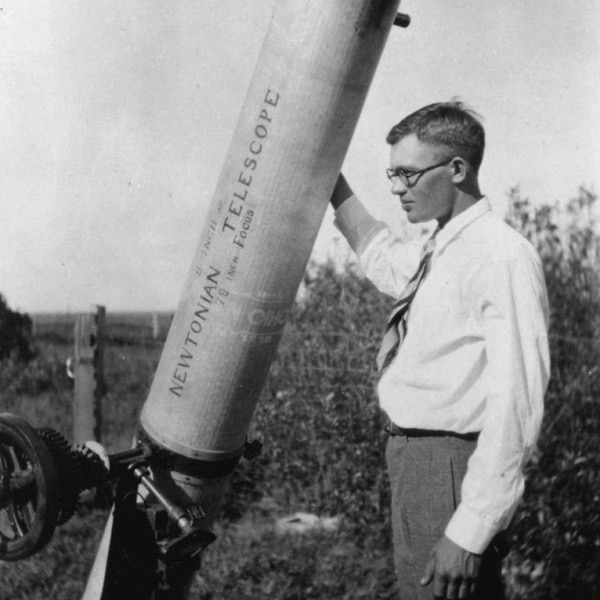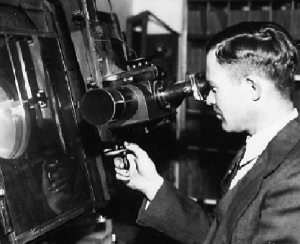

Clyde Tombaugh at his family’s farm with his homemade telescope in 1928, 2 years before his discovery of Pluto. Image via Wikimedia Commons.
February 18, 1930. On this date 90 years ago, a young astronomer was working at Lowell Observatory in Flagstaff, Arizona. Clyde Tombaugh had just turned 25 years old. He’d been hired to continue a search for a ninth planet, begun by Percival Lowell. He’d been at it for about one year. On February 18, 1930, he compared photos of a single star field – taken six days apart a few weeks earlier – and noticed an object that was moving against the backdrop of distant stars. It was a small, dim, remote body in our own solar system. Today, we know this little world as Pluto.
The mystery of Pluto had begun much earlier. Astronomers in the 19th century knew the seventh planet Uranus as outermost planet in our solar system. But they believed something was gravitationally disturbing Uranus’ orbit, and they concluded another planet must exist beyond Uranus. The location of an eighth planet was mathematically predicted. Not long afterwards, in 1846, astronomers searching with telescopes found Neptune – the 8th planet – based on those predictions.
Yet the mystery wasn’t solved. More observations indicated that Uranus’ orbit was perhaps being influenced by yet another planet beyond Neptune. Astronomers referred to it as Planet X.
Enter Percival Lowell. He was a wealthy American businessman with a passion for astronomy. Lowell had gained fame for his notion of canals on the planet Mars. Then he got interested in Planet X. He established Lowell Observatory in Flagstaff and began to search. The search for Planet X remained a priority even after Lowell’s death in 1916.
Clyde Tombaugh was hired by Lowell Observatory in 1929 to continue the search Percival Lowell had begun. Tombaugh, born in 1906, grew up on a farm in Streator, Illinois. He’d dreamed of becoming an astronomer, but gave up the possibility of attending college after his family’s crops were destroyed by a hailstorm. However, he had taught himself mathematical skills required for astronomy, including geometry and trigonometry.
And he observed the skies with his homemade telescope.
When Tombaugh sent drawings he’d made of the planets Mars and Jupiter to Lowell Observatory in Flagstaff, Arizona – hoping to get back some advice – he instead received a job offer. Ultimately, he worked as an observer for Lowell Observatory from 1929 until 1945. After his discovery of Pluto, Tombaugh was awarded a scholarship and began studying astronomy at the University of Kansas, completing his formal education in 1939.
Read more about Lowell’s search for Pluto via Lowell Observatory

Clyde Tombaugh using a device to ‘blink plates,’ that is, to click back and forth between two images of the same patch of sky, taken on two different nights.On those two images, the distant background stars would not appear to move, but closer objects would move from one night to another. Comparing thousands of images, Tombaugh discovered Pluto. Image via Lowell Observatory.
All that time, the mystery of Pluto continued.
Very soon after Pluto’s discovery, astronomers realized it was too tiny to cause the supposed irregularities in Uranus’ orbit. Was there yet another planet lurking out there? This mystery would be solved about 50 years later. New calculations using an accurate mass determination for Neptune, obtained during Voyager 2’s 1982 encounter with the planet, eliminated the need for a Planet X to explain Uranus’ orbit.
In 2006, the International Astronomical Union changed the status of Pluto from one of nine major planets in our solar system to a dwarf planet.
Besides Pluto, there are now numerous bodies in the outer solar system that carry the dwarf planet label, such as Haumea, Makemake, and Eris.
Astronomers believe we will eventually find many more small, spherical worlds in the outer solar system.
And what of Planet X? Interestingly, in 2016, astronomers from CalTech announced new theoretical evidence that a large planet – a Planet X – exists beyond the orbit of Pluto. The video below has more about their work. These astronomers hope this theoretical work will inspire other astronomers to search for Planet X.
And so astronomers are still speculating, and searching.
Bottom line: Clyde Tombaugh discovered Pluto on February 18, 1930, at the Lowell Observatory near Flagstaff, Arizona.
from EarthSky https://ift.tt/20IGXIQ


Clyde Tombaugh at his family’s farm with his homemade telescope in 1928, 2 years before his discovery of Pluto. Image via Wikimedia Commons.
February 18, 1930. On this date 90 years ago, a young astronomer was working at Lowell Observatory in Flagstaff, Arizona. Clyde Tombaugh had just turned 25 years old. He’d been hired to continue a search for a ninth planet, begun by Percival Lowell. He’d been at it for about one year. On February 18, 1930, he compared photos of a single star field – taken six days apart a few weeks earlier – and noticed an object that was moving against the backdrop of distant stars. It was a small, dim, remote body in our own solar system. Today, we know this little world as Pluto.
The mystery of Pluto had begun much earlier. Astronomers in the 19th century knew the seventh planet Uranus as outermost planet in our solar system. But they believed something was gravitationally disturbing Uranus’ orbit, and they concluded another planet must exist beyond Uranus. The location of an eighth planet was mathematically predicted. Not long afterwards, in 1846, astronomers searching with telescopes found Neptune – the 8th planet – based on those predictions.
Yet the mystery wasn’t solved. More observations indicated that Uranus’ orbit was perhaps being influenced by yet another planet beyond Neptune. Astronomers referred to it as Planet X.
Enter Percival Lowell. He was a wealthy American businessman with a passion for astronomy. Lowell had gained fame for his notion of canals on the planet Mars. Then he got interested in Planet X. He established Lowell Observatory in Flagstaff and began to search. The search for Planet X remained a priority even after Lowell’s death in 1916.
Clyde Tombaugh was hired by Lowell Observatory in 1929 to continue the search Percival Lowell had begun. Tombaugh, born in 1906, grew up on a farm in Streator, Illinois. He’d dreamed of becoming an astronomer, but gave up the possibility of attending college after his family’s crops were destroyed by a hailstorm. However, he had taught himself mathematical skills required for astronomy, including geometry and trigonometry.
And he observed the skies with his homemade telescope.
When Tombaugh sent drawings he’d made of the planets Mars and Jupiter to Lowell Observatory in Flagstaff, Arizona – hoping to get back some advice – he instead received a job offer. Ultimately, he worked as an observer for Lowell Observatory from 1929 until 1945. After his discovery of Pluto, Tombaugh was awarded a scholarship and began studying astronomy at the University of Kansas, completing his formal education in 1939.
Read more about Lowell’s search for Pluto via Lowell Observatory

Clyde Tombaugh using a device to ‘blink plates,’ that is, to click back and forth between two images of the same patch of sky, taken on two different nights.On those two images, the distant background stars would not appear to move, but closer objects would move from one night to another. Comparing thousands of images, Tombaugh discovered Pluto. Image via Lowell Observatory.
All that time, the mystery of Pluto continued.
Very soon after Pluto’s discovery, astronomers realized it was too tiny to cause the supposed irregularities in Uranus’ orbit. Was there yet another planet lurking out there? This mystery would be solved about 50 years later. New calculations using an accurate mass determination for Neptune, obtained during Voyager 2’s 1982 encounter with the planet, eliminated the need for a Planet X to explain Uranus’ orbit.
In 2006, the International Astronomical Union changed the status of Pluto from one of nine major planets in our solar system to a dwarf planet.
Besides Pluto, there are now numerous bodies in the outer solar system that carry the dwarf planet label, such as Haumea, Makemake, and Eris.
Astronomers believe we will eventually find many more small, spherical worlds in the outer solar system.
And what of Planet X? Interestingly, in 2016, astronomers from CalTech announced new theoretical evidence that a large planet – a Planet X – exists beyond the orbit of Pluto. The video below has more about their work. These astronomers hope this theoretical work will inspire other astronomers to search for Planet X.
And so astronomers are still speculating, and searching.
Bottom line: Clyde Tombaugh discovered Pluto on February 18, 1930, at the Lowell Observatory near Flagstaff, Arizona.
from EarthSky https://ift.tt/20IGXIQ

Aucun commentaire:
Enregistrer un commentaire